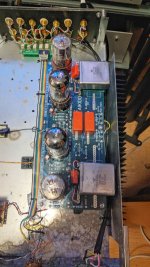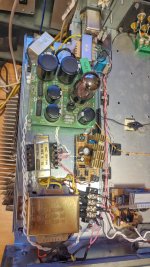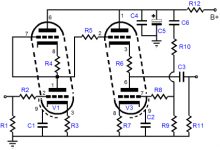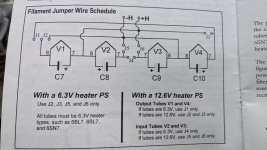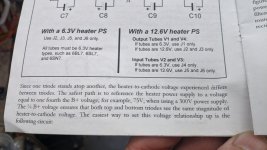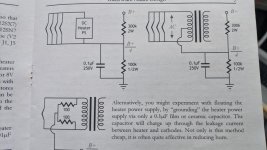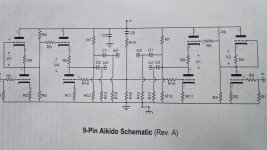Folks,
I have an aikido problem that has evaded me. I built a 6sn7 aikido using the official broskie board and parts, and a valve rectified psu from an old group buy here by bas horneman I think.
Anyway, I hadn't used it in a long time and when I went back and done some tidying up etc I had a lot of rustles and noise - typical of dirty valve sockets. So I swapped out the sockets for new ones from langrex with a few drops of deoxit on each and the noise is gone.
BUT now I have a new issue that is really stumping me. Every now and then, there is a pop that trips the DC protect on the power amp. It's quite quick, and hard to catch on a dmm, but as much as I can see it just barely trips the DC protect at under 1v. It's gone as quick as it came and might not happen for another half an hour or more. There is no other noise from the preamp.
The first thing I thought of was the output caps - maybe those old pio caps are getting leaky, but I swapped in modern film caps from mouser and it happens the same. I also swapped all valves for another set just in case also to no avail. All this is with inputs shorted of course.
Anyone got any ideas? I wondered about oscillation and could go with bigger grid stoppers but I'm not sure it's oscillation.
I have an aikido problem that has evaded me. I built a 6sn7 aikido using the official broskie board and parts, and a valve rectified psu from an old group buy here by bas horneman I think.
Anyway, I hadn't used it in a long time and when I went back and done some tidying up etc I had a lot of rustles and noise - typical of dirty valve sockets. So I swapped out the sockets for new ones from langrex with a few drops of deoxit on each and the noise is gone.
BUT now I have a new issue that is really stumping me. Every now and then, there is a pop that trips the DC protect on the power amp. It's quite quick, and hard to catch on a dmm, but as much as I can see it just barely trips the DC protect at under 1v. It's gone as quick as it came and might not happen for another half an hour or more. There is no other noise from the preamp.
The first thing I thought of was the output caps - maybe those old pio caps are getting leaky, but I swapped in modern film caps from mouser and it happens the same. I also swapped all valves for another set just in case also to no avail. All this is with inputs shorted of course.
Anyone got any ideas? I wondered about oscillation and could go with bigger grid stoppers but I'm not sure it's oscillation.
Attachments
B+ is 310v and the heaters are elevated to 110v....
Try instead B+ / 4 = 78 VDC and see if the noise is less.
Ok will do.
The entire heater string (all 4 valves) are elevated which I think should be ok, but no harm to check I suppose.
The entire heater string (all 4 valves) are elevated which I think should be ok, but no harm to check I suppose.
Can you post the heater schematic? Be sure the elevation point is decoupled to ground.
At present you are really pushing the lower tubes. You have to rule out the possibilities one by one.
At present you are really pushing the lower tubes. You have to rule out the possibilities one by one.
Pics from the booklet attached. I see Broskie also recommended 1/4 B+ as well. I'll change that tomorrow.
Exactly what would you recommend for decoupling - the same as Broskie in the circuit attached?
Exactly what would you recommend for decoupling - the same as Broskie in the circuit attached?
Attachments
Depends on the impedance of the elevation resistors.
Certainly the 0.1uF shown would be the minimum. I've used up to 100uF.
But don't use excessive resistor values, no more than 100k to ground.
The B+ / 4 elevation makes the upper and lower Vh-k voltages equal (but opposite polarities).
Certainly the 0.1uF shown would be the minimum. I've used up to 100uF.
But don't use excessive resistor values, no more than 100k to ground.
The B+ / 4 elevation makes the upper and lower Vh-k voltages equal (but opposite polarities).
Last edited:
I had a Proton D-1200 that had the same kind of pop every once in while. It ended up being the capacitors for the higher voltage supply. They were known to go bad and of course there was no replacement that would fit the chassis. Of course mine was SS and yours is tube, but? I will also mention the bad capacitor did not test bad. I'm betting testing for leakage would find it.
Ok. Great suggestions there. First thing to do is change the elevation, check the decoupling and see if there's a change and I'll report back.
Many thanks to you for your help and comments.
Many thanks to you for your help and comments.
As I recently found with my Aikido build, increasing the .1 bypass cap to 1uF will eliminate any residual hum in the heater supply, something that had been bothering me for ages. May not solve your problem, but it will lower the noise floor considerably.
300K, 0.1uf, 47k (100K : use 47K would give you around 70v at 290v B+ with tubes.)
Without tubes, the B+ is around 330v. I don't see different between 280v-300v
C5: 50uF poly
C6: 10uf better
You may need 3.3kuF 16V for heater.
Without tubes, the B+ is around 330v. I don't see different between 280v-300v
C5: 50uF poly
C6: 10uf better
You may need 3.3kuF 16V for heater.
Just an update, but no resolution so far.
I adjusted the elevation - 200k-68k which with a B+ of 310-320V works out at 85-87V elevation. This stays below the 100V max K-gnd in the datasheet. The 68k is decoupled with 47uF.
Just to refresh here- the main issue here are the random output that causes the DC protection in the power amp to trigger (this is one of those simple u1237 ebay modules). I did wonder if it might be oscillation, so I increased the grid stoppers to 1k with no change.
What I was wondering - if the DC protect is triggered, then it could be DC (naturally, but this would mean the output cap is leaking), but could it be high frequency oscillation that is fooling the u1237? Maybe I am overthinking it.
I also left a DMM sitting on the outputs for a while and observed (inputs shorted). The meter floats around a few mV, but randomly rapidly floats up to the low hundreds of mV and back down again randomly. Given that the meter is slow, this could mean higher spikes that the DMM is missing. I think I need to let it run and observe on the scope for a while.
I adjusted the elevation - 200k-68k which with a B+ of 310-320V works out at 85-87V elevation. This stays below the 100V max K-gnd in the datasheet. The 68k is decoupled with 47uF.
Just to refresh here- the main issue here are the random output that causes the DC protection in the power amp to trigger (this is one of those simple u1237 ebay modules). I did wonder if it might be oscillation, so I increased the grid stoppers to 1k with no change.
What I was wondering - if the DC protect is triggered, then it could be DC (naturally, but this would mean the output cap is leaking), but could it be high frequency oscillation that is fooling the u1237? Maybe I am overthinking it.
I also left a DMM sitting on the outputs for a while and observed (inputs shorted). The meter floats around a few mV, but randomly rapidly floats up to the low hundreds of mV and back down again randomly. Given that the meter is slow, this could mean higher spikes that the DMM is missing. I think I need to let it run and observe on the scope for a while.
The network including C6 is a hum canceler. Try removing C6 to see if the amp is motorboating or if said C6 is leacky.
I can try C6 for sure - but it is a Wima MKP so its fairly unlikley.
Great idea on the peak hold function - I will definitely do that and report back.
The only regulators are on the heaters for either rectifier or 6sn7 valves.
Great idea on the peak hold function - I will definitely do that and report back.
The only regulators are on the heaters for either rectifier or 6sn7 valves.
- Home
- Amplifiers
- Tubes / Valves
- Aikido octal pops/dc
